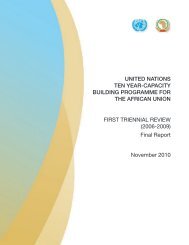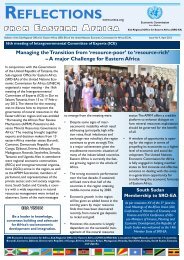Tool kit for Gender and Agriculture - Economic Commission for Africa
Tool kit for Gender and Agriculture - Economic Commission for Africa
Tool kit for Gender and Agriculture - Economic Commission for Africa
You also want an ePaper? Increase the reach of your titles
YUMPU automatically turns print PDFs into web optimized ePapers that Google loves.
20<br />
Improving <strong>Agriculture</strong> through <strong>Gender</strong> Analysis<br />
• Animal traction increases the area cultivated <strong>and</strong> so increases women’s work in<br />
weeding, unless weeding by animal-drawn weeders is also adopted.<br />
• Sedentarization of pastoral societies increases women’s work: women often assume<br />
new responsibilities <strong>for</strong> crop production; the new grain-based diet requires more<br />
processing, cooking, <strong>and</strong>, there<strong>for</strong>e, collection of water <strong>and</strong> fuel than did the previous<br />
meat-based diet.<br />
• The introduction of modern hybrid varieties requires additional, seasonal, <strong>and</strong><br />
timely labor inputs <strong>and</strong> increases female labor requirements <strong>for</strong> maximum yields.<br />
Box 3: Underestimation of De Facto Female-Headed Households<br />
In a survey of 3,405 households in the Senegal Valley, 95 percent of all households<br />
were identified as male-headed; however, a baseline survey of 365 households in the<br />
same area found only 91 percent of households to be headed by men. A breakdown of<br />
these figures shows that of these male heads of households:<br />
8 percent were under 8 years old<br />
4 percent were 8 to 14 years old<br />
26 percent were over 14 years old but absent<br />
In fact, 47 percent of households were headed by men who were adult <strong>and</strong> present.<br />
Similarly, in a Mauritanian survey, although 77 percent of households were<br />
headed by men, only 53 percent had the traditional profile of a husb<strong>and</strong>, his wife or<br />
wives, <strong>and</strong> children present on the farm.<br />
Constraints common to men <strong>and</strong> women farmers can be addressed by generally<br />
improving the agricultural environment <strong>and</strong> the responsiveness of agricultural services<br />
to all farmers. But often, merely gender-neutral policies are not adequate; a more proactive<br />
strategy is required to ensure that projects take into account existing gender imbalances,<br />
promote equitable access to resources <strong>and</strong> benefits, <strong>and</strong> motivate both men<br />
<strong>and</strong> women to participate in project activities. Moreover, gender roles change over<br />
time. These changes must be reflected in the design <strong>and</strong> implementation of agricultural<br />
projects. Sector work <strong>and</strong> project preparation become crucial in this regard.<br />
B. Borrower Country Ownership<br />
<strong>Gender</strong> issues are more complex <strong>and</strong> difficult to address than technical or managerial<br />
issues; they may need more time, sensitivity, <strong>and</strong> resources. The World Bank’s policy<br />
is to:<br />
• Review legal <strong>and</strong> regulatory frameworks<br />
• Assist member countries to design gender-sensitive policies <strong>and</strong> programs<br />
• Strengthen the data base <strong>for</strong> gender planning <strong>and</strong> monitoring







